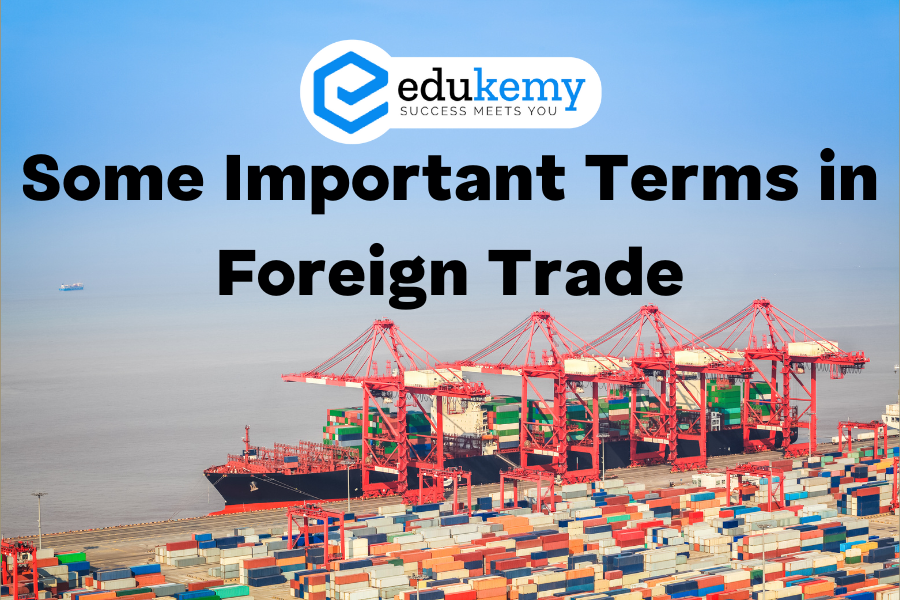
Foreign trade, also known as international trade, is a fundamental aspect of the global economy, facilitating the exchange of goods and services across national borders. It encompasses a wide array of terms and concepts crucial for understanding the dynamics of trade between countries. From tariffs and quotas to exchange rates and trade agreements, these terms shape the landscape of international commerce, influencing economic growth, geopolitical relations, and consumer welfare. A grasp of these key terms is essential for businesses, policymakers, and individuals navigating the complexities of the interconnected global marketplace. In this introductory exploration, we delve into some important terms in foreign trade, shedding light on their significance and implications in the ever-evolving world of international commerce.
Contents
Some Important Terms:
- DGFT (Directorate General of Foreign Trade):
- Headed by the Director General of Foreign Trade.
- Responsible for formulating and executing exim (export and import) policy, including licensing.
- EPZs (Export Processing Zones) and EOUs (Export Oriented Units):
- EPZ: Special enclaves providing a duty-free environment for export production, separate from the national market (DTA – Domestic Tariff Area).
- EOU: Complementary to the EPZ scheme, dispersed in various locations, facilitating export-oriented production.
- Forfaiting:
- Finance companies collect money due to exporters from importers for a commission.
- Forfaiters assume risks associated with receivables.
- RoDTEP (Remission of Duties or Taxes on Export Product):
- Introduced in 2019 by the Government of India to replace the Merchandise Exports from India Scheme (MEIS).
- Monitored by the Ministry of Finance (MoF) and claimed to be WTO-compatible.
- Deemed Exports:
- Refers to inputs used in exports, receiving similar concessions as actual exports for promotion.
- EPCG (Export Promotion Capital Goods) Scheme:
- Allows manufacturers to import capital goods for export production at a concessional rate against a specified export obligation.
- EEFC (Exchange Earners Foreign Currency) Account Scheme:
- Introduced in 1992, enables exporters and other exchange earners to retain a portion of their receipts in foreign exchange with an authorized dealer in India.
- ITC (HS) – Indian Trade Classification (Harmonised System):
- System classifying products for export and import purposes.
- Counter Trade:
- International barter where goods are paid for with other goods.
- ASIDE (Assistance to States for Development of Export Infrastructure and other activities) Scheme:
- Scheme providing assistance to states for developing export infrastructure and related activities.
FAQs
Q: What is Trade Balance?
A: Trade balance refers to the difference between a country’s exports and imports of goods and services. If exports exceed imports, it results in a trade surplus, while if imports surpass exports, it leads to a trade deficit. This balance is crucial for assessing a nation’s economic health and its relationship with other countries.
Q: What is Tariff?
A: Tariff is a tax imposed on imported goods by a government. It’s often used as a means to protect domestic industries from foreign competition or to generate revenue for the government. Tariffs can vary based on the type of goods, country of origin, or specific trade agreements in place.
Q: What is Free Trade Agreement (FTA)?
A Free Trade Agreement is a pact between two or more countries to reduce or eliminate barriers to trade such as tariffs and quotas. FTAs promote trade liberalization and foster economic cooperation among participating nations. They aim to stimulate economic growth by facilitating smoother flow of goods and services across borders.
Q: What is Exchange Rate?
A: Exchange rate refers to the value of one currency in terms of another currency. It determines the rate at which one currency can be exchanged for another. Exchange rates fluctuate based on various factors including interest rates, inflation, and geopolitical events. They play a crucial role in international trade by influencing the competitiveness of exports and imports.
Q: What is Dumping?
A: Dumping occurs when a country exports goods to another country at a price lower than the normal value in the exporting country. This practice can harm domestic industries in the importing country by undercutting their prices and leading to job losses. Anti-dumping measures such as tariffs or quotas may be imposed to counteract the effects of dumping and protect domestic producers.
In case you still have your doubts, contact us on 9811333901.
For UPSC Prelims Resources, Click here
For Daily Updates and Study Material:
Join our Telegram Channel – Edukemy for IAS
- 1. Learn through Videos – here
- 2. Be Exam Ready by Practicing Daily MCQs – here
- 3. Daily Newsletter – Get all your Current Affairs Covered – here
- 4. Mains Answer Writing Practice – here

